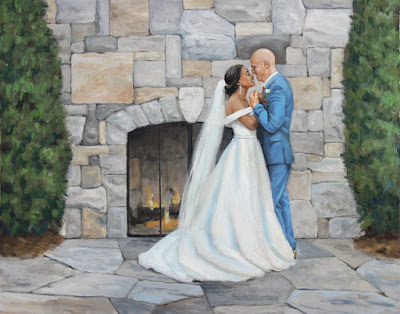This time of Covid is giving me plenty of time to experiment with new techniques and approaches in painting, play with new ideas, and generally try stuff that I often don't get to try. I just had an experiment that, I think, gave me some new tools for my artistic toolbox. Here's what happened.
I've been working on my family history for many decades now. Last year, I was sorting through some old photos and came across this one from about 1920:
The two on the left are my grandparents. They were apparently clowning around with their friends somewhere over the Hudson River. What really grabbed my attention, though, was the guy on the right. In the photo, he's laughing, but with just a tiny change to his expression, he could be crying out. Remember the Nazi in the movie "Raiders of the Lost Ark", the guy whose face melted at the end? Yeah, this guy in the photo kinda looks like him. So I thought it would be fun to take this old photo and see if I could make it creepy. I took a swing at it last year and this was the result:
I titled it "The Undertakers". I thought the end result was pretty "meh", but didn't really know why. So I shrugged my shoulders and went on with other experiments.
Recently, I was looking at the work of a really interesting painter, Anne Magill. Her paintings are often dark, with a very limited range of colors. Here's a sample:
I was looking at her artwork and asking myself what feelings they evoked in me, and one of the responses was "mystery". And then I remembered that mystery was one of the feelings I was trying to get out of "The Undertakers". So I pulled it off the shelf, set it up on an easel, and compared it to Magill's paintings. And I realized that, in my painting, I told the viewer way too much. Too much detail in the faces. Too much light. Too much color. Too much other stuff: cracks in the rock, trees, people. It didn't give the viewer room to create a story of their own. So I pulled out another canvas the same size as the first one and transferred the same composition over to the new canvas. Then I went to work: simplifying the composition (one of the figures and all the trees are gone), reducing the details, reducing the range of colors, and trying to keep the attention focused where I wanted it. It took a couple of weeks, but I called it done and here it is:
This version is much better than the first one. I don't know that I'd call it a winner, but I certainly learned a lot from it. There are several things that I'd do differently if I had to do it again. Maybe I'll go back over it in a week or two and make some more changes. But it's definitely closer to my original intention than the first painting. I'm working on another project right now that uses many of the same ideas, but in a very different way. We'll see how that one comes out. Meanwhile, I'm pretty happy to have a new tool in my studio toolbox!





